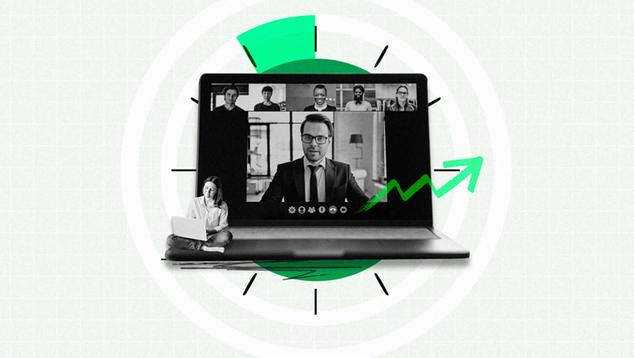As remote work and hybrid work became mainstream in the wake of the pandemic, many leaders have asked these questions: Are remote workers really working? What does that mean for productivity?
The answer is nuanced. Remote workers are spending less time working, but the relationship between remote work and productivity is more complex.
Remote Employees Are Working Less
A recent study based on data from the American Time Use Survey (ATUS) from 2019 to 2023 found that full-time employees in remote-capable jobs are spending less time on work and more on personal activities.
By 2022, people in heavily remote roles were working about an hour less per day than in 2019, on average. Of that time, they were redirecting 30 to 60 minutes to leisure, a trend consistent with broader remote work productivity statistics. This decrease goes beyond reduced commute time, with the drop in commuting time accounting for only a small fraction of the reduction in work hours.
Some groups reported working even less. In jobs open to telework, men, unmarried adults, and those without children showed the steepest declines in hours worked and the greatest gains in leisure time. For example, single men over 45 who work remotely clocked over two hours less per day on work activities in 2022 than in 2019. Women saw even larger declines in hours worked, although that is driven largely by those without a college degree.
These findings align with more recent Gallup studies on hours worked and emerging remote work trends in the broader workforce. In 2019, U.S. employees reported working an average of 44.1 hours. In 2024, they averaged 42.9 hours per week.
Productivity Benefit of Remote Work: Increased Talent Pool
Perhaps the greatest concern in boardrooms about reduced work hours is the potential hit to productivity. If employees are working 10% fewer hours, will output or innovation fall by 10%?
Not necessarily.
After adjusting a model where employees choose jobs based on their capabilities and preferences, the study finds a slight increase in output per worker in the economy. This growth did not result from employees in more remote-intensive jobs working more productively. Instead, people were better able to sort into roles that were better suited for them, and employment shifted toward sectors with higher output per worker.
Organizations that broke free from geographic constraints and hired the best-fit talent for each role — regardless of location — experience a boost in remote work productivity. While the ATUS does not capture information on the quality of managers, prior Gallup data show that managers play a vital role in how technological change affects employees. That is, increases in technology tend to have positive effects on workers, but those effects are greater when managers build trust in the workplace. The bar for managerial quality is likely even higher for those leading remote employees. Knowing how to manage a remote team is now a core leadership competency. It affects how clearly organizations set expectations, manage performance and build trust.
Although the model addresses sector-level and overall productivity, the benefits for individual organizations are more complex. They depend not only on the types of tasks being done and how suitable they are for remote work, but also on the makeup of the talent pool. Growing evidence shows that being near coworkers can have positive spillovers for productivity, and the effect of working in the same location on communication depends on the type of work and whether the interaction is between employees or between employees and managers.
These factors are especially important for younger or newer employees who may not yet have established routines or communication patterns within the organization. For them, working in the same location as their coworkers could provide more benefits.
Remote Work Increases Job Satisfaction — If the Boss Is Bad
Even if the productivity benefits of remote work are mixed, employers might offer remote flexibility as a perk to attract and retain quality employees. Gallup data on hybrid work suggest as much: 76% of hybrid workers say “improved work-life balance” is one of the “greatest benefits” of hybrid work. For many, the ability to work from home offers greater autonomy and flexibility. That is consistent with several randomized experiments assessing the effects on retention, including those by Nicholas Bloom and coauthors. But companies need to recognize how fully remote strategies can go awry by attracting people who are less likely to put in discretionary effort.
Company culture, however, has a stronger influence on employees’ feelings about their workplace than location. Another recent study found that workplace factors — such as feeling appreciated and receiving clear communication, among other workplace practices — explain most of the differences in job satisfaction and intent to leave.
Meanwhile, remote work is linked to job satisfaction in the raw data. But that link disappears when accounting for the previously mentioned workplace factors, except for one group: employees who “sometimes work from home.” In other words, workers value some flexibility, but culture and management matter more.
The study also shows that the benefits of remote work are not the same for everyone — they vary based on the type of work and the quality of the manager. This suggests that remote work can feel like a benefit when management falls short, but it does not raise performance on its own.
In these cases, fully remote work arrangements may help individuals make the best of a bad situation, but that is a workaround, not an organizational strategy.
The Best Hybrid Work Model Focuses on Culture and Fit
The future of hybrid work and remote work is already here. What matters now is how much flexibility to allow, how it works in practice and how organizations manage the risks. These choices rest with managers and organizational leadership.
- Build a strong workplace culture first. Most variation in job satisfaction and intent to leave comes from how employees view their workplace practices, not from compensation. Hybrid work can support engagement, but it cannot replace sound management. High-quality management remains a competitive advantage.
- Assess your workforce and how work gets done. Remote work fits some tasks better than others. Organizations need to understand the factors that influence successful client outcomes and how these are evolving with the economy and technology. Use both remote work and on-site collaboration in ways that elevate performance.
- Use remote work to expand your talent options and improve role fit. Productivity increases when people are doing work that suits their talents and strengths. Remote and hybrid work arrangements create more ways to match employees to the right tasks under a clear talent strategy.
Bottom Line
Less time spent working does not automatically mean lower output. If anything, the shift to hybrid and remote models has helped many organizations make better use of each employee’s talents. But the declining trend in time allocated to work, particularly among remote-capable employees, and the deteriorating employee engagement trend Gallup has documented for years indicate a broader risk. With this risk in mind, leaders need to ensure remote work flexibility strengthens — not erodes — long-term engagement and performance.
Build a remote strategy that works for people and performance.
- Track the latest trends in remote and hybrid work.
- Get proven strategies to lead remote teams with clarity, trust and accountability.
- Learn why great management, not location, improves employee wellbeing.




